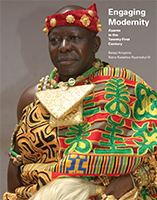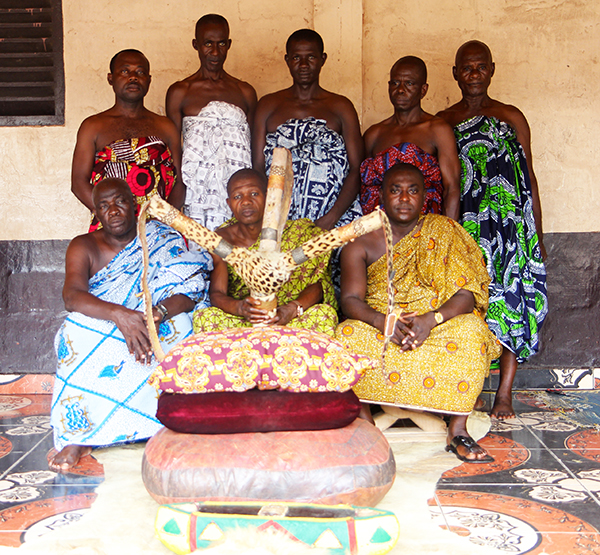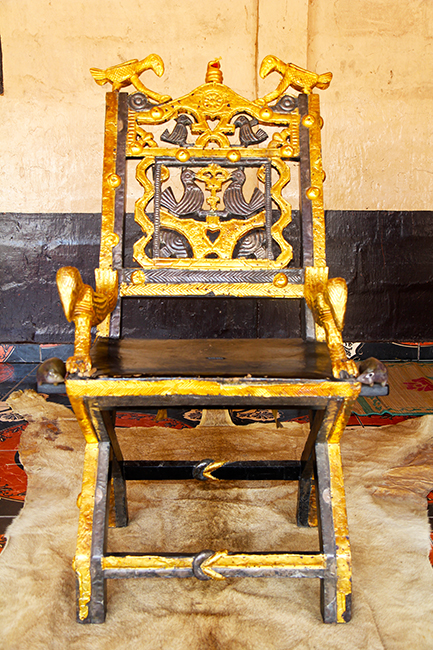
Engaging Modernity: Asante in the Twenty-First Century
Skip other details (including permanent urls, DOI, citation information): This work is licensed under a Creative Commons Attribution-NonCommercial-NoDerivatives 3.0 License. Please contact [email protected] to use this work in a way not covered by the license.
For more information, read Michigan Publishing's access and usage policy.
Nyame Dua (Tree of God)
In distressed situations such as funerary rites for a member of the royal family, a paramount chief, Abrempɔn or a national tragedy, the Asantehene does not sit on royal stools and chairs when he is presiding over those ceremonies. Rather he sits on top of atɛ (cushions) placed on top of a pintaa (leather cushion) propped against a modeled Nyame Dua (Tree of God) to denote his reliance on the Supreme Being for spiritual fortitude to enable him to withstand the period of anguish. Another context for the king to use this sitting arrangement is the annual funerary rites for all deceased members of the royal family including those in the Ɔyoko areas. Known as otue ayikɛseɛ (plucking the grand funerary rites), it is an occasion that brings together all the paramount chiefs in the kingdom for remembrance rites. The altar to the Supreme Being in traditional Akan homes is a three-pronged tree branch with a basin placed on top for offerings to the Supreme Being. After rainfall, the rainwater collected in the basin is considered holy for the deposited water came straight from the heavens and as a result, it is used for special rituals. The picture to the right is a replica and a movable nyame dua with nsuman (talismans) attached to two leather straps that are attached to the two branches to the left and right. The tree is covered with leopard leather with gold and black metal rings on the stem and the tree branches.

Description: Two atɛ (cushions) made of velvet fabric are placed on top of pintaa (a leather cushion) which is in turn placed on gyata nwoma (lion skin), with akrokroaa (foot rest) also placed on the lion skin, while the nyame dua is placed behind the cushions.
Left to right: Nana Owusu Soadwa (Anumfoɔ Nkonwasoafoɔ Mmamahene), Onyampinin IV (Otumfoɔ Danpɔanohene), Baafoɔ Akwasi Dabanka IV (Otumfoɔ Nkonwasoafoɔhene)
Standing from left: Yaw Kankam Boadu, Kofi Wusu, Opanin Kwadwo Amo, Yaw Boakye
Kɔdeɛ

Description: Kɔdeɛ (the eagle) on both sides of the backrest with nankabɔbɔnini (a coiled gabbon viper). Like the gaboon viper, the Asantehene will never attack or fight without provocation. Directly below the viper is tadeɛ (a lake).
A step down in the corners are the adwera leafs. The designs are ɛdwene. Gold studs are replicas of sliced halvesof ankaa dwea (lemons). Armrests are carved eagles. Below the armrests are abotokura. All the seats are made of antelope skin. The brace under the seat is the nyansapɔ (wisdom knot).
Hwɛdɔm
From the Twi word hwɛ (looking at) dɔm (people). Spoken Twi: ɔhwɛ ɛdɔm. In the past, Asantehene would sit on this chair when declaring war. Currently, the king uses this chair when he presides over serious court cases. On top of both sides are funumatu (the navel). Between the navel is the ntuatire that is placed in the middle of the backrest, the end part of dɛnkyɛmkyɛ with the top part broken off. The circular gold embossed on the back seat consists of aya (fern leafs), a navel in the center, with the dɛnkyɛmkyɛ on top. The gold studs are sliced ankaa dwea as in the case of kɔdeɛ. The armrests are supported by a twisted rope design that extends to the chair stand.
Nnamu (Akonkromfi)
The design is such that the king sits in a restful posture since these types of chairs are used on joyous occasions. The nnamu chairs are also known as akronkromfi for they resemble the pose of a praying mantis. The ntuatire (on top of the chair) is the gyemirekutukyɛ (the bosomuru hat) and on both sides are the sedeɛ (cowrie shells). The backrest with the elaborate designs are an abstraction of the adinkra symbol, dwanini mmɛn (rams horns) with silver studs and silver ankaa dwea. The armrests are abstractions of another Adinkra design, Gyawu atikɔ (Gyawu’s backhead), while the round designs beneath the seat are replicas of ɔware (counting board game). A bell is strapped underneath the seat.
Dwetɛ Nnamu
Nnamu with silver studs and similar designs as the nnamu above but looks much older. The design of the backrest is an abstraction of dwanini mmɛn (the rams horns), while the armrests are abstractions of Gyawu atikɔ (Gyawu’s back head).
Asipimtia
Low seat chair (short chair) decorated with large and small silver studded nails. Circular embossed design is tadeɛ (a lake). Notice the nsuman below the seat.
Abosomaketrɛ/Asipimtia
One of the items taken away to Britain but returned during Asantehene Agyemang Prempeh II’s reign is this asimpimtia chair named after its ntuatire, abosomaketrɛ (the chameleon). With the chameleon, the king is indicating that this chair was taken far away to Britain but slowly like the abosomaketrɛ, it returned to Kumase. It is embossed with a circular gye nyame symbol (accept the power of God; the omnipotence of the creator) on the back of seat. The abosomaketrɛ chair is of the asipimtia variety.
Kukuruboɔ/Asipimtia
Specifically for funerary rites, this chair is identified by the ntuatire, kukuruboɔ. It is elaborately designed with silver studded nails and embossed circular silver with aya (fern leaves) on the backrest. The saying in Twi is: ma ya kokoase aya, me bɛgyae me ti hihim ni? (lit., I’m like the fern leaf under the cocoa tree; will I ever stop shaking my head?)
Sikwadwa Hwɛdɔm (Hwɛdɔmtea)
Since the Gold Stool is never allowed to touch the ground, it is placed on top of this hwɛdɔmtea that is appropriately called, sikadwa hwɛdɔm. During ceremonies, the chair is also placed on ɛsono aso (the skin of an elephant ear) known in Twi by the general name banwoma. The big circular ornament on the backrest is tadeɛ (a lake). As usual, the funumatu (navel) is placed on the topsides with small and large ankaa dwea studs decorating the edges. All ornaments are plated with gold.
Kɔtɔkɔdwa
As in the previous stool, kɔtɔkɔdwa is plated with gold ornaments. Two cast iron bells are attached and unlike the fotɔaba, only two sides of the legs have the round form. There are four suman attached to the base. This ceremonial stool was made for the present king, Otumfoɔ Osei Tutu II.
Fotɔaba
Brown wooden stool with gold repouse decoration representing the fotɔaba (the seeds used in a counting board game). It is impossible to break the fotɔ seed. The circular legs also represent the fotɔaba. Two cast iron bells are attached to each side by leather thongs. Six suman (talismans) are attached to the base for spiritual protection. Similar to the decorated chairs, stools are always placed on banwoma. In this picture, the fotɔaba is placed on a gyata banwoma (lion leather).
A Set of Stools, Chair, and Cushions
On special occasions such as the adaɛkɛseɛ or a fairly big akwasidaɛ that take place at pramaso (the big open space outside the palace), the Asantehene sits on kɔtɔkɔdwa with twelve colorful velvet and silk-covered cushions. Known in Twi as atɛ (ntɛ, pl.) the cushions are arranged in ascending order on the kɔdeɛ chair that is placed behind a stool. The kɔtɔkɔdwa is placed on gyata nwoma (lion leather) with atɛ (a pillow-shapped cushion) placed on it. There are three visible circular cushions with a yellow and black circular middle for the first two representing taadeɛ (a lake). Bɔaman is the third, top-most cushion with a black square, four triangular shapes, and one rectangular shape. There are nine additional cushions behind the three cushions for a total of twelve cusions. The akrokoaa (footrest) is placed on the leather carpet in front of the kɔtɔkɔdwa. As would be expected, the entire setup is placed on gyata banwoma (lion leather).






















